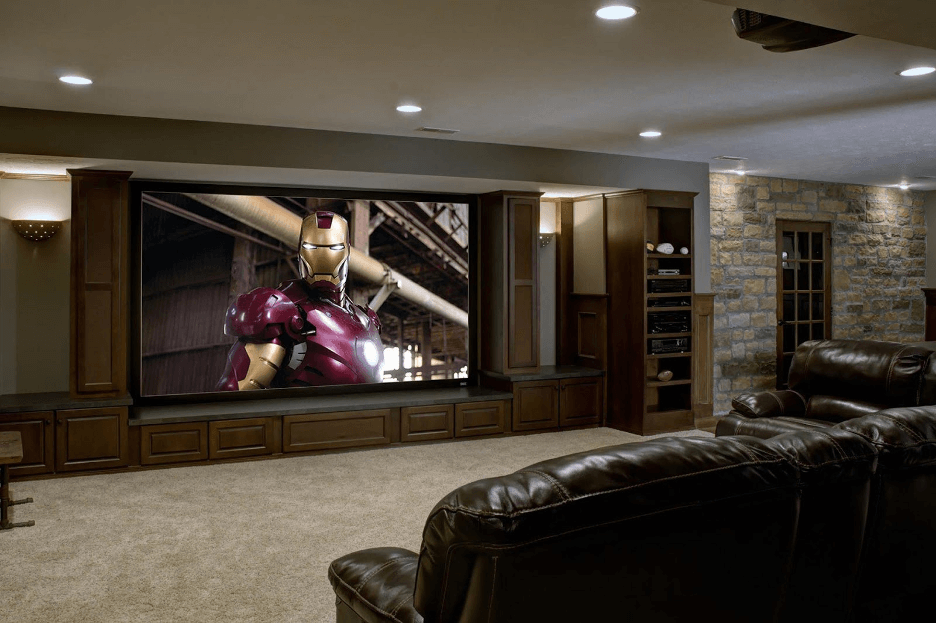When many people think of their dream home, they might envision a room with a home theater. This is a place of ultimate relaxation and escape — a room to get away from the hustle and bustle of life and kick back with a good movie.
Renovating a room to become a home theater is attainable — but you definitely need to know the key areas to consider. Take a moment to think about what your perfect theater includes, what it looks like, and what it adds to your home. Let’s walk through our professional home theater guide so you can learn how to create a space that fits your needs.
Building a Professional Home Theater: 4 Considerations
Location is Key
Where is your home theater going to be in your house? This is one of the first decisions you must make. For instance, a basement remodel or renovation is one of the best ways to add a home theater. Since they usually lack windows and natural light, they’re dark and quiet. This creates an ideal environment for a big screen and large, comfy couches that usually don’t fit in a traditional family room.
Another option is to build a room addition for the home theater. This is ideal if you don’t have an existing space that would transform well into a media room. Connect it to an area of the home that’s easy to access, yet won’t disturb people who are in nearby rooms. Talk to your contractor about the best location for an addition that will function as a home theater.
Tip: Location is also important for a consistent, strong Wi-Fi signal. Most likely the entertainment platforms in your media room will require Wi-Fi, so put your home theater in a place that can obtain a strong signal at all times. You don’t want to be dealing with the headaches of lost connections in the middle of your movie.
Size Matters
When it comes to a home theater, make sure the size of the space is appropriate for your vision. Do you want to have risers with large, reclining seats similar to a real movie theater? You’ll need a huge space. If you don’t have the square footage needed for bulky furniture and risers, you’ll have to opt for smaller (or fewer) seating options.
Size also matters when it comes to your movie screen. If you plan to have a drop-down movie screen with a video projector, you’ll need a massive, windowless wall. You also want to make sure your movie screen and seating are compatible. If your space is small and requires the seating to be too close to a massive movie screen, for example, viewers might be overwhelmed and uncomfortable. Smaller TVs or screens are more suitable for tighter spaces.
Audio is Important, Too
A positive audio experience goes hand-in-hand with an enjoyable movie-viewing experience. In a typical room, audio bounces off the walls, ceiling, and flooring. If you can limit that bounce in your theater room, the sound from your movie will be much better.
You have a few options for creating a great audio experience in your home theater:
- Use wall-to-wall carpeting, which helps reduce echoing and audio bouncing
- Opt for lots of plush draperies and soft coverings for windows or walls
- Choose furniture with soft, thick cushions, which will help absorb sound and prevent it from bouncing
- Sound-proof your walls to keep loud audio from bothering people in other rooms of the house
Lighting (or Lack of Lighting) is a Factor
For most rooms of the home, you want good lighting whenever possible. For a typical room, the best way to obtain good lighting is with plenty of windows. But in a home theater, you want darkness for best media-viewing and as little glare as possible. If you build your home theater in a basement or a room with few windows, install dimmable light fixtures, like recessed lighting or sconces, to give the room a “movie theater” vibe and keep brightness levels in your control.
Also, consider painting the room with dark colors like gray or black, including the ceiling. Use flat or matte sheens. Light, bright colors (such as white) are meant to reflect maximum light. In a home theater, however, you want to minimize that light reflection to prevent glare on your movie screen.
No matter how elaborate you plan to go, make sure to consider the above factors when building a home theater. It’s up to you (and your budget) how complex your media room will be — from simple to full-blown — but lighting, audio, location, and size all make a difference. Talk to your contractor about these considerations as you begin your home theater project.
Professional Home Theater Design, Remodels, Renovations, and Room Additions in Columbus, Ohio
Dave Fox is an employee-owned company that makes our clients our number one priority. We design and build remodeling, renovation, and addition projects for our clients in Central Ohio and deliver the best value through exceptional craftsmanship, excellent materials, and ethical business practices. Contact us today to learn more and sign up for our newsletter here!

